Same Love - how to shoot LGBTIQ weddings
Gone are the days where marriage was a union reserved solely for a man and a woman. A global movement to legalise same-sex marriage is seeing a rise of LGBTIQ weddings; something wedding photographers may never have captured in their careers. Christopher Quyen talks with LGBTIQ familiar wedding photographers for an insight.
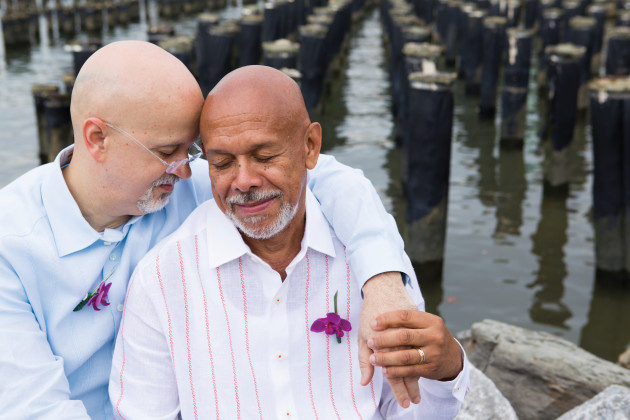
Under Australian marital law, marriage is defined as “the union of a man and a woman to the exclusion of all others.” It’s a cringe-worthy phrase for anybody who shares the belief that love is, and should be, equal. Today, Australia still fights for equal marriage rights with same-sex advocates hoping 2015 will be the year of legalised same-sex marriage, but overseas, LGBTIQ (Lesbian, Gay, Bisexual, Transgender, Intersex, Queer) people and communities are standing triumphant. As of now, 36 states in the United States of America and 17 countries, including South Africa, Scotland, Canada and New Zealand, have legalised same-sex marriage.
So what does this mean for the wedding photography industry? For New Hampshire-based photographer, Thea Dodds, it means growth. “Having an entirely new clientele enter the wedding market is not something that will come around again. This is pretty much the biggest thing that will happen to wedding professionals… ever,” she says. With this new segment in the market, some photographers will have to rethink their approach to wedding photography to accommodate their clients. However, there seems to be a lack of education available in the industry. To fill this gap, Dodds and her co-author Kathryn Hamm, president of GayWeddings.com, an online resource of support and information for same-sex couples, have designed a first-of-its kind book, The New Art of Capturing Love: The Essential Guide to Lesbian & Gay Wedding Photography. As well as this, professionals are now offering workshops and it is a subject often raised in talks and lectures. The future of wedding photography is clear, and bright.

Through new eyes
People often ask whether photographing same-sex couples and weddings is the same as shooting a traditional wedding. In many respects it is, however because most professional wedding photographers only know traditional weddings, they may fall victim to placing certain marital and societal values on gay couples. Brooklyn-based photographer, Steven Rosen, who runs a workshop on photographing same-sex couples, and recently won “People’s Choice” in the 2014 Rangefinder Wedding Photography contest, finds that this is the biggest blunder a photographer can make. “Understanding and appreciating the fluidity of gender expression in the community gives you a big advantage,” he says. “The single biggest mistake a photographer can make when working with a same-sex couple is to assign male and female gender roles.” And this is where your skills as an observer come into play. “If you’ve never photographed a same-sex couple, you should practise. If you know any LGBTIQ couples, ask if they’ll pose for you, or if they can introduce you to someone who will. If there’s no one in your circle that you can turn to, look for models, but make sure they’re in a relationship. This gives you the chance to see the balance, in that particular couple, or traditionally masculine and feminine attributes,” says Rosen. While this is something to abide by, Washington DC-based documentary photographer, Maggie Winters, says it’s important to not treat couples too differently. “Same-sex couples are no different from any other couple you’ve photographed. There’s no reason to treat someone differently because of their gender role,” she says. But Hamm believes that sometimes the most effective method is the direct method. “Don’t assume anything about gender roles or what the couples wants or how they express themselves. Ask!” she suggests.
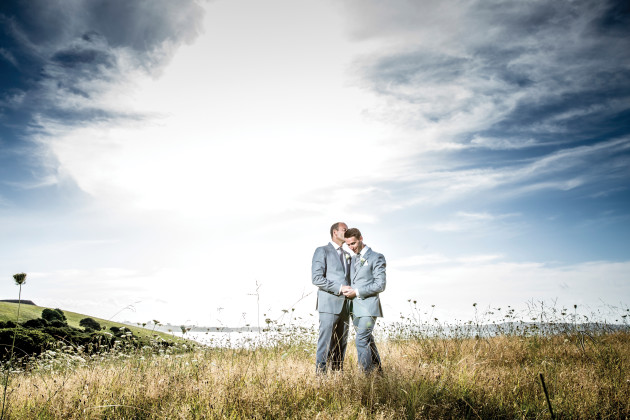
Tuning in
Discovering the best way to tell your client’s story often starts with a conversation, but with same-sex clients, terms such as bride and groom or bridal party are becoming irrelevant, and certainly awkward, to use. As we enter this new era of weddings, using vocabulary that is relevant to the client is important. Brooklyn-based photographer, Sarah Tew, makes an effort to ensure that gender-neutral language is present in all her dealings. “When I started booking same-sex weddings, I had to check through all the language in my website, inquiry responses, contract and pre-wedding questionnaires to make sure that I wasn’t excluding or alienating same-sex couples with the words ‘bride and groom,’” says Tew. Similarly, Diane Stredicke, of Hudson River Photographer, reiterates using inclusive language in your everyday life as well. “I always refer to my clients using inclusive language such as ‘couple’, ‘clients’, ‘wedding party’ or ‘wedding portraits,’” says Stredicke. It’s quite the juggling act, but you want to make sure you approach your clients with only the best intentions to make them feel comfortable with capturing their relationship.
Once you have the correct vocabulary, it’s time to figure out your approach. There are many approaches to shooting a same-sex couple, but it all comes down to gathering information about the couple. Communication, asking the right questions and observing what their relationship is like as a natural and organic thing are all factors that will assist. “Sometimes I ask things like how they cuddle on the couch to watch their favourite TV show. Whose head is on whose shoulder or lap? I like to encourage my clients to be themselves as much as possible,” says Rosen, emphasising the importance of staying open to everything. It is also important to ask if the couple is comfortable with PDA (Public Displays of Affection) as there are still many places and people in the world who do not take kindly to same-sex couples. For many straight photographers, it may be their first exposure to homophobia. The best thing to do is usually just move on, relocate and not react, but keep the focus on making the couple feel at ease, suggests Rosen.
Compose yourself
Photographers who have never captured a same-sex relationship could experience difficulty posing or guiding same-sex couples as Dodds recalls. “My ‘regular bag of tricks’ was no help when I tried to convey the level of intimacy I usually capture at a wedding. Posing my first same-sex couple, because they were so similar in height and weight and couldn’t physically dip or lift each other, made the ‘standard’ wedding images difficult,” says Dodds. The attire of the wedding couple also presents visual challenges when dealing with either a double gown or suit combination. Many photographers attribute this to a long history of emphasis on the bride. “In some shots, the groom is primarily there to present the bride,” says Rosen, “however, it does present a chance for photographers to re-invent the couple shot.” Ben and Erin Chrisman from Chrisman Studios, one of Rangefinder Magazine’s Top 10 sought-after wedding photographers in the world, play with symmetry when presented with a double dress or suit combination. “If there are two dresses, then we make sure to treat each one like it’s just as special as the other one. Having two of everything definitely helps the symmetry of a photo,” says Ben Chrisman. A double suit combination presents a slightly different problem, however. “When you have two guys in matching black tuxedos and they embrace, it creates a big black blob and you can’t tell where one person begins and the other ends,” says Rosen. He recommends using side lighting to create an edge that visually separates the tuxedos, or to have one of the grooms take their jacket off to create contrast between a white shirt and black jacket.
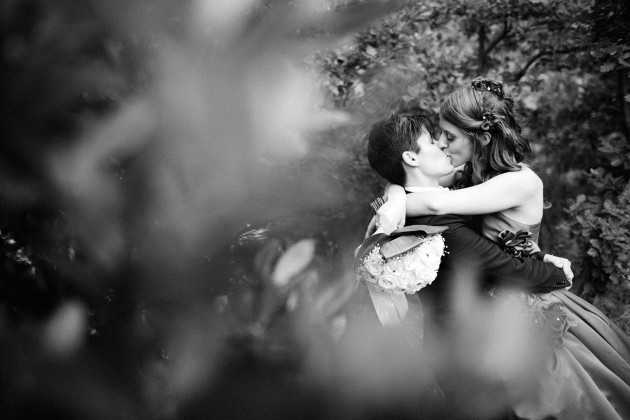
In your pursuit of beautifully capturing the relationship, your overall goal should be to create something that communicates that the two people in your photographs really do love each other. “The main thing in photographing two men together is to make sure they don’t just look like good buddies, or the groom and the best man. You want the photos to feel like a couple who is intimate and in love,” says Stredicke. Both Stredicke and Winters take a photojournalistic approach with their couples, preferring to provide their clients with a genuine moment so they can capture their love in its natural state. “One of our couples had a secret handshake, one had a hilarious dance they did together, and each photo session reflects our couples’ individuality. When I scream “MORE KISSING!” at our couples, sometimes they kiss, sometimes they crack up, but every single time, it’s a total reflection of who they are as humans,” says Winters. You can compose your shots or you can take a photojournalistic approach, but with either approach, it’s useful to know how to work with both sides of the same coin.
The big day
Don’t assume anything traditional on the wedding day. While some LGBTIQ couples embrace tradition, many create their own. Rosen recalls only ever witnessing one bouquet toss out of all the same-sex weddings he has photographed, while Stredicke has seen male couples twist old traditions and have their own bouquet toss. Sydney-based Frank Farrugia, was inspired to establish Same Love Photography in Sydney and Melbourne after photographing his first double-gown couple. Since turning his focus to the LGBTIQ community, he has noticed that traditions are evolving within same-sex weddings. “If there is a beautiful tradition worth mentioning, it is more in terms of the scheduling of the day. Same sex-couples typically prepare for their ceremony together. This provides a great opportunity for photographers to capture the couple in what will be a very intimate and loving moment in time. In this particular instance, the traditional emphasis on the grand reveal isn’t so important, and this in turn allows photographers to utilise the available time to take the couple outdoors and capture some beautiful portraits once they are ready, instead of only after the ceremony,” says Farrugia. “And when it comes to walking down the aisle, unlike traditional weddings where the groom waits at the head of the ceremony for his bride, in same-sex ceremonies, it’s common for each bride and groom to walk up the aisle with their parents or together, hand-in-hand,” he says.
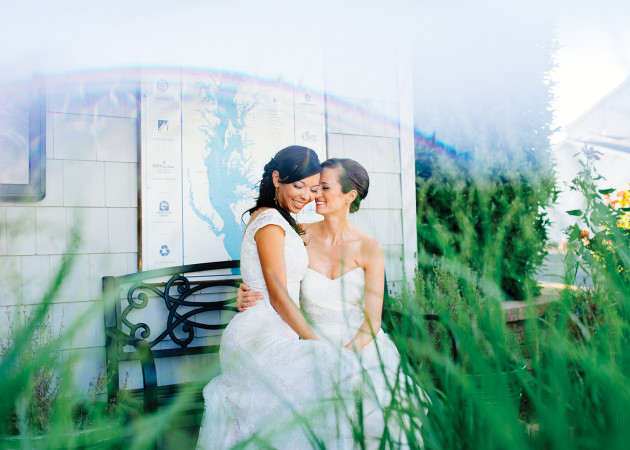
In terms of photographing the guests at the wedding, those who are present are usually supportive of the wedded couple, but sometimes there are some guests who can be uncomfortable when they arrive. “If you can spot those guests early on, you can grab pictures of them as the day progresses and, if you’re lucky, you can see the acceptance start to wash over them. It’s kind of cool,” says Rosen. The parents are another story though, especially when they do not agree with the wedding couple’s union, as their presence or absence can really impact on your client’s emotional state, as found by Italian wedding photographer, Julian Kanz. “I’m always very disappointed if there is only one half of the parents or, even worse, no parents at all. Once, during the ceremony, one of the brides read a message from her father who was not present at the wedding. He wrote that he did not agree with her decision but wanted to let her know that he will always love her anyway. It was probably one of the most emotional moments I have experienced,” says Kanz. He also mentions, as a travelling wedding photographer, that your location can also influence the atmosphere of the wedding. “Many Italian people are very conservative when it comes to marriage, so for some Italians it’s still strange to see same-sex weddings, and this is the exact opposite to Amsterdam. A gay wedding in the Netherlands it the most normal thing in the world.”
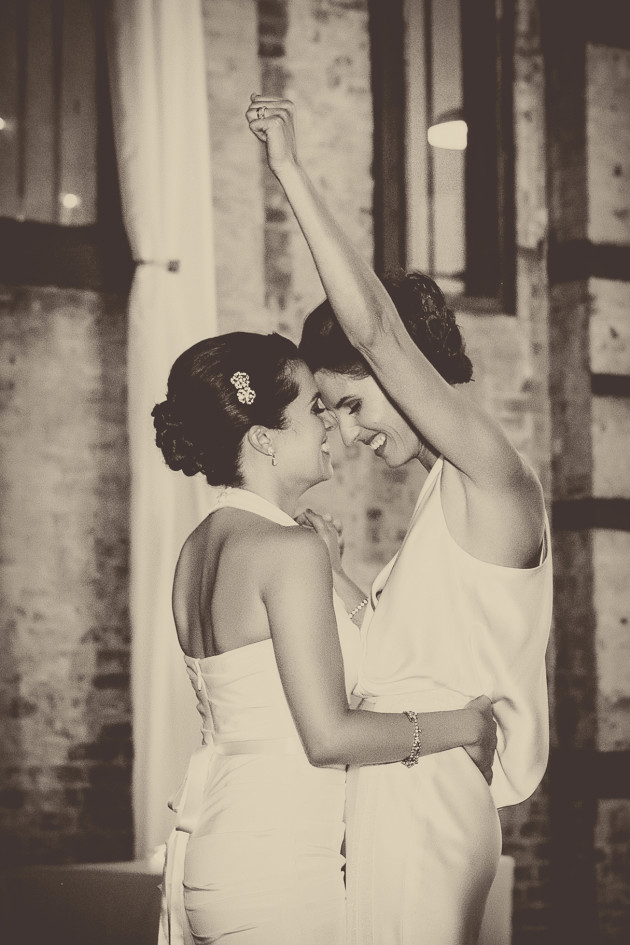
© Sarah Tew.
The love business
The demand for professional photographers who understand same-sex couples is becoming a moving force in the industry. M.V. Lee Badgett of the Williams Institute at UCLA Law has estimated that same-sex weddings are worth $1.5 billion alone, in terms of what couples are likely to spend on all that goes into a wedding. And with more educated, same-sex clients who want the best their money can buy, competition for the “right” photographer can certainly be fierce. Therefore, the need to understand the LGBTIQ community is integral for this new market segment. “These days, I watch wedding professionals lose business not because they aren’t willing to work with same-sex couples, but because they haven’t translated their support into effective business and marketing practices,” says Hamm. “They haven’t, as I like to say, made the leap from being ‘gay-friendly’ to being gay wedding competent.” Furthermore, to find clientele from the LGBTIQ community, both Rosen and Farrugia suggest getting involved with it. “One of the ways I have been able to develop my profile, while supporting the journey to marriage equality, is by providing my services to the peak national lobby group, Australian Marriage Equality. It has given me both profile and unique opportunities to document eminent Australians like Kylie Minogue, Jimmy Barnes and, most recently, Anthony Callea and Tim Campbell,” says Farrugia. Rosen also says that niche advertising works for the LGBTIQ community. “If there are any online publications that cater to same-sex couples getting married, try them out. I’ve had very good luck with a number of sites here in the US,” he says.

Burning bright
Many same-sex couples travel to other countries to experience the same marital rights as straight couples do. “Of all NZ same-sex weddings, 26% are Australians seeking the dignity that New Zealand willingly offers,” says Farrugia. Many photographers now travel overseas to photograph same-sex weddings because of the quality of their work, and it’s only a matter of time before we see same-sex marriage hit our shores in Australia. Until then, photographers should do their best to prepare and educate themselves on the sensitivities and approaches towards this new clientele. But if there’s one sentiment that many LGBTIQ involved photographers share it’s this: There will come a day where love is no longer between a man and a woman, but between love and love.
Contacts
| Ben and Erin Chrisman | www.chrismanstudios.com |
| Thea Dodds | authenticeye.com |
| Frank Farrugia | www.samelove.com.au |
| Kathryn Hamm | gayweddings.com |
| Julian Kanz | www.juliankanz.com |
| Steven Rosen | www.stevenrosenphotography.com |
| Diane Stredicke | www.hudsonriverphotographer.com |
| Sarah Tew | www.sarahtewphotography.com |
| Maggie Winters | maggiewinters.com |

